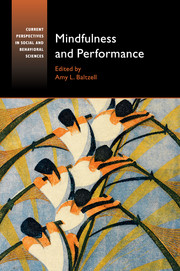Book contents
- Frontmatter
- Dedication
- Epigraph
- Contents
- List of figures
- List of tables
- List of contributors
- Preface
- Acknowledgments
- I INTRODUCTION TO MINDFULNESS: HISTORY AND THEORETICAL UNDERSTANDING
- II FORMAL MINDFULNESS INTERVENTIONS IN SPORT
- III MINDFULNESS: THEORY TO PRACTICE IN SPORT AND EXERCISE
- IV MINDFULNESS AND THE PERFORMING ARTS
- 15 Langerian Mindfulness and Optimal Performance
- 16 Mindfulness and Dancers
- 17 Attention, Centering, and Being Mindful: Medical Specialties to the Performing Arts
- 18 Mindfulness in Music
- V MINDFULNESS FOR COACHES, PRACTITIONERS, AND MENTORS
- VI FUTURE DIRECTIONS
- Index
- References
17 - Attention, Centering, and Being Mindful: Medical Specialties to the Performing Arts
from IV - MINDFULNESS AND THE PERFORMING ARTS
Published online by Cambridge University Press: 05 January 2016
- Frontmatter
- Dedication
- Epigraph
- Contents
- List of figures
- List of tables
- List of contributors
- Preface
- Acknowledgments
- I INTRODUCTION TO MINDFULNESS: HISTORY AND THEORETICAL UNDERSTANDING
- II FORMAL MINDFULNESS INTERVENTIONS IN SPORT
- III MINDFULNESS: THEORY TO PRACTICE IN SPORT AND EXERCISE
- IV MINDFULNESS AND THE PERFORMING ARTS
- 15 Langerian Mindfulness and Optimal Performance
- 16 Mindfulness and Dancers
- 17 Attention, Centering, and Being Mindful: Medical Specialties to the Performing Arts
- 18 Mindfulness in Music
- V MINDFULNESS FOR COACHES, PRACTITIONERS, AND MENTORS
- VI FUTURE DIRECTIONS
- Index
- References
Summary
My experience is what I agree to attend to.
William James (cited in Gallagher, 2009, p. 1)As a performer, the act of mindfulness is a valuable and optimal state of being. One's ability to be mindful can discernibly affect physical performance in a diverse range of contexts; for example, a dancer performing as part of a group, or a doctor answering a question in an oral exam. This chapter explores the notion of mindfulness, with a particular focus on the aligned concepts of attention and centering, among performing artists and medical practitioners. Despite the obvious disparities of challenges and tasks between the performing arts and medical specialties, the relevance of mindfulness proves a distinguishable commonality across the disciplines. Throughout this chapter, case study examples will be drawn upon to illustrate the pertinence of mindfulness for the performer and also the important contextual considerations for the performance psychologist.
Mindfulness is being in touch with the present moment. It also involves paying attention in an engaged way. Deciding what to pay attention to takes work. When the performance psychologist is working with the client, he or she needs to be aware of the sociocultural context in which the performance is embedded. Understanding the social norms of the performance domain and the expectations of important others (e.g., family and/or colleagues) is beneficial when endeavoring to enhance the client's performance. In the case studies that follow, we apply a range of psychological skills within different sociocultural contexts, with the goal of enhancing the mindful approach of the performer. It is essential to understand the context when tailoring mindfulness-based interventions. For example, the anesthetist mixing a cocktail of sleep-inducing drugs prior to an operation has substantially different demands and pressures placed upon her or him than an actor about to walk on stage to a full house on the first night. While the hospital registrar and voice student may share similar performance anxiety in relation to their exams, they have different social norms that create a set of background expectations in which performance is compared. However, one thing they all have in common is the need for mindfulness in what they do, and the effective psychologist encourages adaptation of mindfulness to a variety of different performance domains and deals with numerous factors that inhibit mindful performance.
- Type
- Chapter
- Information
- Mindfulness and Performance , pp. 389 - 411Publisher: Cambridge University PressPrint publication year: 2016
References
- 1
- Cited by

